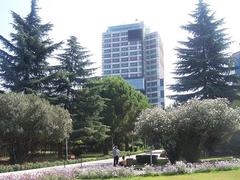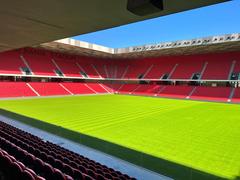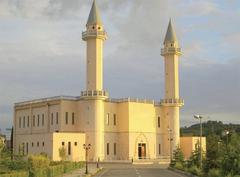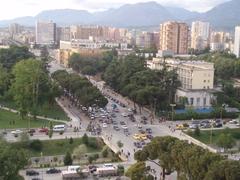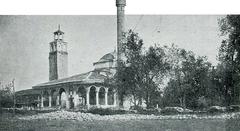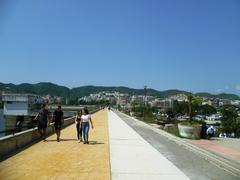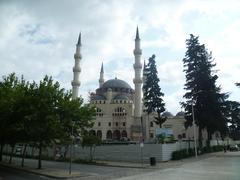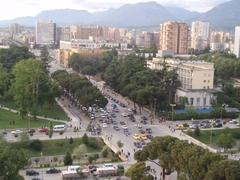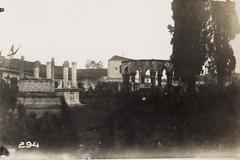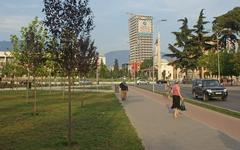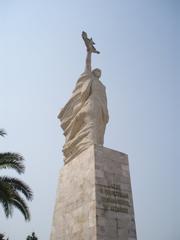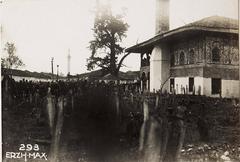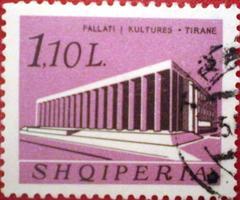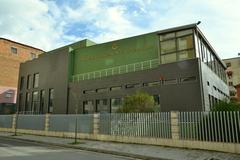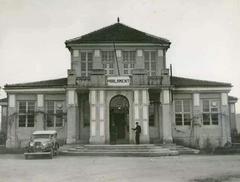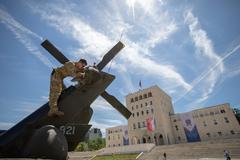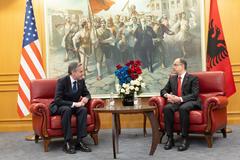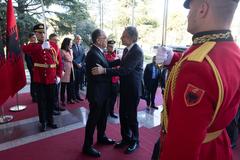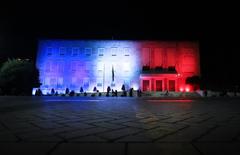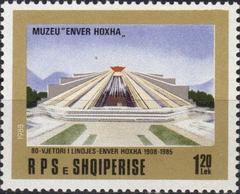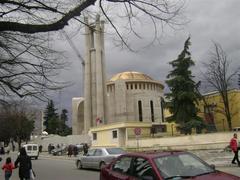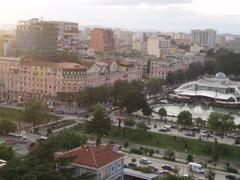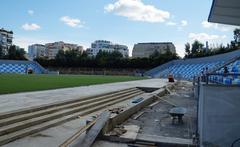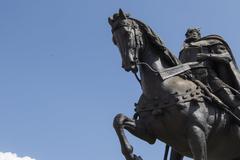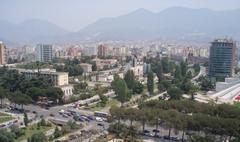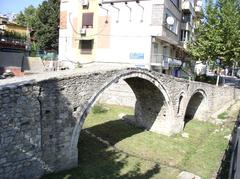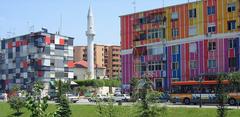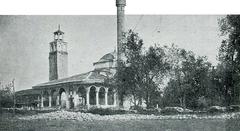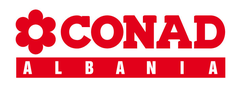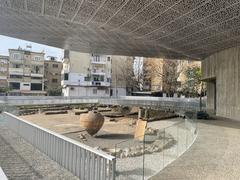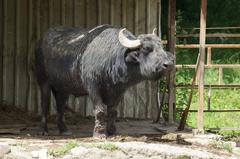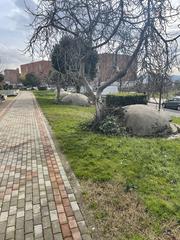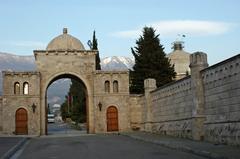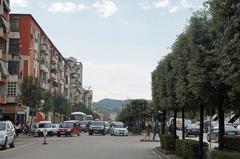Skanderbeg Square Tirana Albania: Visiting Hours, Tickets, and Travel Guide
Date: 14/06/2025
Introduction
Skanderbeg Square (Sheshi Skënderbej) is the cultural and historical heart of Tirana, Albania’s capital. Named after the national hero Gjergj Kastrioti Skanderbeg, the square is both a symbol of Albania’s national identity and a living, vibrant urban space. Its surrounding ensemble—ranging from Ottoman-era landmarks and Italianate government buildings to communist and contemporary architecture—creates a unique urban tapestry. Whether you are a history enthusiast, architecture lover, or curious traveler, this guide provides detailed, non-duplicative information on Skanderbeg Square’s history, architecture, visiting hours, tickets, accessibility, and travel tips, ensuring a memorable experience in Tirana’s iconic plaza.
For additional context, consult Tirana Municipality, Visit Tirana, and Closer Lives.
Table of Contents
- Introduction
- Historical Evolution of Skanderbeg Square
- Architectural and Cultural Landmarks
- Symbolism and Contemporary Role
- Visiting Hours and Tickets
- Accessibility and Facilities
- Travel Tips and Nearby Attractions
- Events and Guided Tours
- Frequently Asked Questions (FAQ)
- Conclusion and Recommendations
- References
Historical Evolution of Skanderbeg Square
Early 20th Century Origins
Skanderbeg Square’s location became pivotal when Tirana was declared Albania’s capital in 1920. The area was once home to the Old Bazaar and Ottoman neighborhoods. The first plans for a central plaza appeared in 1917, initiated by Austrian planners during World War I (Wikipedia; Closer Lives).
Italian Urban Planning Influence (1920s–1930s)
Significant development began in the 1920s and 1930s, as Italian architects like Armando Brasini and Gherardo Bosio reimagined Tirana. Their plans introduced a grand, Neo-Renaissance square, with a roundabout, central fountain, and architectural symmetry. The square was officially named after Skanderbeg in 1937 (Tirana Municipality). Italian fascist occupation in 1939 further transformed the square’s perimeter with monumental government buildings.
Communist Era Transformation (1945–1991)
After World War II, the communist regime extensively redesigned the square. The Old Bazaar was demolished to make way for the Palace of Culture, and statues of Stalin and later Skanderbeg became focal points. The Skanderbeg Monument, a dramatic equestrian statue, was unveiled in 1968. The square became a stage for political rallies and socialist celebrations (Closer Lives; Visit Tirana; Wikipedia).
Post-Communist Renewal and Modernization (1991–Present)
Following the fall of communism, Skanderbeg Square underwent a profound transformation. Statues and symbols of the old regime were removed. After serving as a major traffic hub, a major redesign was completed in 2017 by Belgian firm 51N4E and artist Anri Sala, making the area fully pedestrianized and unifying disparate architectural elements with a mosaic of stones from across Albania (51N4E; Architectural Review; Visit Tirana).
Architectural and Cultural Landmarks
Skanderbeg Square’s surroundings feature a blend of historical and modern architecture:
- National Historical Museum: The country’s largest museum, famous for its socialist-realist mosaic façade (Closer Lives; Far Out Travel).
- Et’hem Bey Mosque: A late 18th-century mosque renowned for its rare frescoes of natural scenes (Tirana Municipality; Matias Travel).
- Clock Tower: Built in 1822, offering panoramic city views.
- Palace of Culture: Home to the National Opera and Ballet Theatre and National Library (Architectural Review).
- Tirana International Hotel: A modernist landmark.
- Bank of Albania, City Hall, and various ministries: Reflecting Italian and communist architectural styles (Architectural Review).
- Bunk’Art 2: A Cold War bunker-turned-museum (Albania Travel Guide).
The square’s pedestrian-friendly design, open spaces, and over 100 fountains (using recycled rainwater) create a lively ambiance for events, festivals, and daily life (Albania360).
Symbolism and Contemporary Role
Skanderbeg Square is a microcosm of Albanian unity. Its surface is paved with 129,600 tiles from every Albanian region, symbolizing inclusivity and national identity (Architectuul). The sloped plaza, with its highest point at the center, represents the gathering of people from all walks of life. The Skanderbeg Monument at its core is a powerful reminder of Albania’s resilience and spirit (Albania Visit).
As the primary venue for public gatherings, celebrations, farmers’ markets, and artistic performances, Skanderbeg Square fosters civic pride and social interaction (Penguin Travel). Its design is a contemporary expression of Albania’s complex history and ongoing renewal.
Visiting Hours and Tickets
Skanderbeg Square: Open 24/7 and free to visit.
Attractions around the square:
- National Historical Museum: Open Tuesday–Sunday, 10:00–18:00 (closed Mondays). Entry: ~200–500 ALL (€2–4).
- Et’hem Bey Mosque: Open outside prayer times (typically 9:00–12:00 and 15:00–17:00). Free entry; modest dress required.
- Clock Tower: Open 9:00–18:00; entry fee ~150–200 ALL (€1.35–€1.50).
- Palace of Culture & National Opera: Open during events; ticket prices vary.
Tickets for museums and the Clock Tower are available on-site. Guided walking tours can be booked in advance or with local operators.
Accessibility and Facilities
- Pedestrianized and wheelchair-friendly, with smooth pavements, ramps, and accessible toilets.
- Museums and the Tourist Information Office nearby offer resources for visually impaired visitors and those with limited mobility (Motion4Rent).
- Free public Wi-Fi is available throughout the square.
- ATMs, currency exchange, and accessible bathrooms are nearby.
Travel Tips and Nearby Attractions
- Best Times to Visit: Early mornings or late afternoons avoid crowds and heat. June is vibrant due to cultural festivals.
- Dress Code: Modest attire for religious sites; casual for public spaces.
- Transport: The square is a central hub for city buses and airport shuttles. Taxis are widely available.
- Currency: Albanian Lek (ALL); cash preferred for small transactions.
- Language: Albanian is official; English and Italian are widely spoken in tourism.
- Local Food: Enjoy cafés and restaurants around the square serving Albanian specialties.
Nearby Attractions:
- Pyramid of Tirana: 10-minute walk; former museum, now a cultural and tech center.
- Tirana Castle: Historical walls now house shops and cafés.
- Bunk’Art 2: Museum on Albania’s communist past, a short walk away.
- New Bazaar (Pazari i Ri): Fresh produce, local crafts, and lively street life.
Events and Guided Tours
Skanderbeg Square hosts Independence Day (Nov 28), Liberation Day (Nov 29), Tirana Photo Festival (June), open-air concerts, and international cultural weeks. Free walking tours depart daily from the square and last 1.5–2 hours; tipping guides is customary. Private and themed tours are also available.
Frequently Asked Questions (FAQ)
Q: Is Skanderbeg Square always open?
A: Yes, the square is open to the public around the clock.
Q: Are tickets required?
A: No tickets for the square itself. Museums and the Clock Tower charge small entrance fees.
Q: Is the square accessible for people with disabilities?
A: Yes, it is fully pedestrianized and equipped for wheelchair access.
Q: Can I join a guided tour?
A: Yes, free and private tours are available daily.
Q: When is the best time to visit?
A: June for festivities; mornings and evenings for fewer crowds.
Conclusion and Recommendations
Skanderbeg Square is more than the geographic center of Tirana; it is the embodiment of Albania’s layered history, cultural dynamism, and resilient spirit. Its architectural diversity, abundant events, and inclusive design make it a must-visit for every traveler. For the fullest experience, explore the surrounding museums, join a guided tour, and sample local cuisine. Download the Audiala mobile app for the latest event updates, maps, and personalized itineraries to enrich your visit.
For further information, explore Architectural Review, Albania360, and the additional resources below.
References
- Closer Lives
- Wikipedia
- Tirana Municipality
- Visit Tirana
- 51N4E
- Architectural Review
- Albania360
- Motion4Rent
- ArrivalGuides: Tirana
- The Scrapbook of Life
- The Crazy Tourist
- Albania Travel Guide
- Matias Travel
- Far Out Travel
- Architectuul
- Albania Visit
- Penguin Travel
- Balkan Kaleidoscope
- Alexandra Travel
- World Wild Schooling
- Wander-Lush
